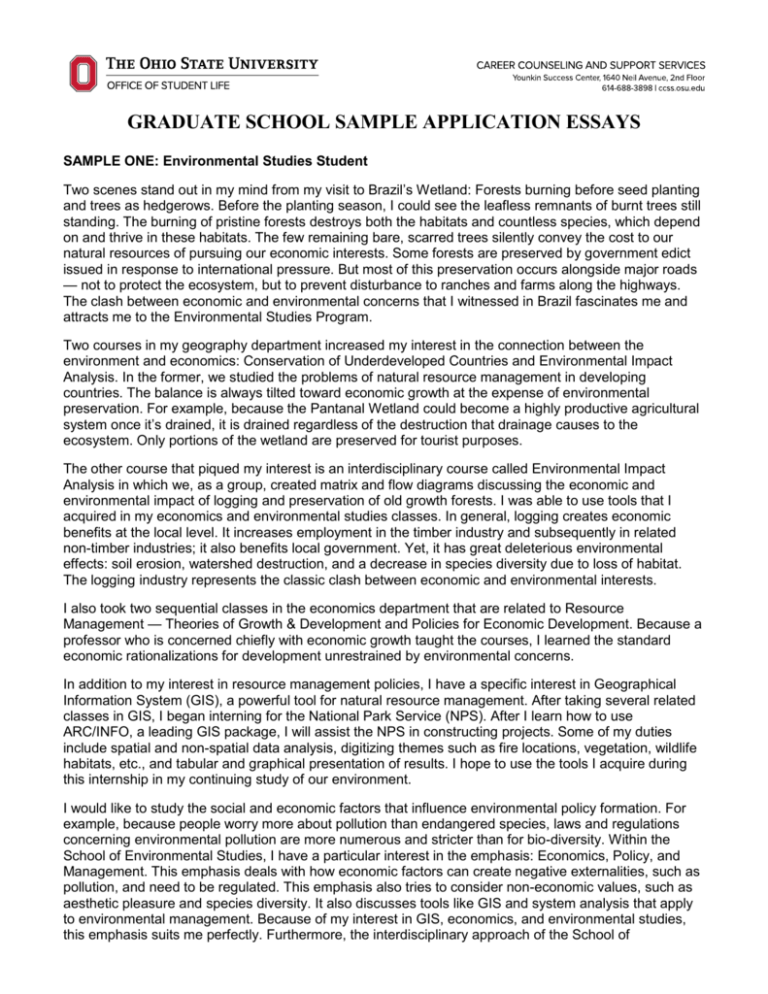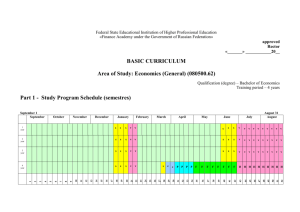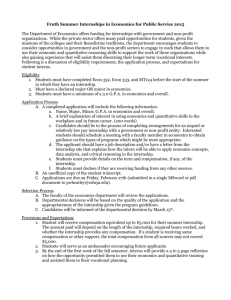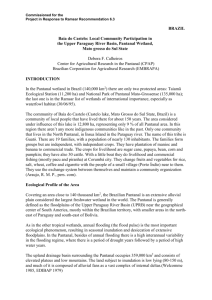Sample Essays
advertisement

GRADUATE SCHOOL SAMPLE APPLICATION ESSAYS SAMPLE ONE: Environmental Studies Student Two scenes stand out in my mind from my visit to Brazil’s Wetland: Forests burning before seed planting and trees as hedgerows. Before the planting season, I could see the leafless remnants of burnt trees still standing. The burning of pristine forests destroys both the habitats and countless species, which depend on and thrive in these habitats. The few remaining bare, scarred trees silently convey the cost to our natural resources of pursuing our economic interests. Some forests are preserved by government edict issued in response to international pressure. But most of this preservation occurs alongside major roads — not to protect the ecosystem, but to prevent disturbance to ranches and farms along the highways. The clash between economic and environmental concerns that I witnessed in Brazil fascinates me and attracts me to the Environmental Studies Program. Two courses in my geography department increased my interest in the connection between the environment and economics: Conservation of Underdeveloped Countries and Environmental Impact Analysis. In the former, we studied the problems of natural resource management in developing countries. The balance is always tilted toward economic growth at the expense of environmental preservation. For example, because the Pantanal Wetland could become a highly productive agricultural system once it’s drained, it is drained regardless of the destruction that drainage causes to the ecosystem. Only portions of the wetland are preserved for tourist purposes. The other course that piqued my interest is an interdisciplinary course called Environmental Impact Analysis in which we, as a group, created matrix and flow diagrams discussing the economic and environmental impact of logging and preservation of old growth forests. I was able to use tools that I acquired in my economics and environmental studies classes. In general, logging creates economic benefits at the local level. It increases employment in the timber industry and subsequently in related non-timber industries; it also benefits local government. Yet, it has great deleterious environmental effects: soil erosion, watershed destruction, and a decrease in species diversity due to loss of habitat. The logging industry represents the classic clash between economic and environmental interests. I also took two sequential classes in the economics department that are related to Resource Management — Theories of Growth & Development and Policies for Economic Development. Because a professor who is concerned chiefly with economic growth taught the courses, I learned the standard economic rationalizations for development unrestrained by environmental concerns. In addition to my interest in resource management policies, I have a specific interest in Geographical Information System (GIS), a powerful tool for natural resource management. After taking several related classes in GIS, I began interning for the National Park Service (NPS). After I learn how to use ARC/INFO, a leading GIS package, I will assist the NPS in constructing projects. Some of my duties include spatial and non-spatial data analysis, digitizing themes such as fire locations, vegetation, wildlife habitats, etc., and tabular and graphical presentation of results. I hope to use the tools I acquire during this internship in my continuing study of our environment. I would like to study the social and economic factors that influence environmental policy formation. For example, because people worry more about pollution than endangered species, laws and regulations concerning environmental pollution are more numerous and stricter than for bio-diversity. Within the School of Environmental Studies, I have a particular interest in the emphasis: Economics, Policy, and Management. This emphasis deals with how economic factors can create negative externalities, such as pollution, and need to be regulated. This emphasis also tries to consider non-economic values, such as aesthetic pleasure and species diversity. It also discusses tools like GIS and system analysis that apply to environmental management. Because of my interest in GIS, economics, and environmental studies, this emphasis suits me perfectly. Furthermore, the interdisciplinary approach of the School of Environmental Studies attracts me since it combines social science’s strengths with knowledge of the natural sciences necessary to protect and preserve the environment. After completing my masters program, I would like to continue my education and obtain a Ph.D. in natural resource management. This degree would enable me to combine a teaching career with advising business and government on natural resource management issues. Teaching college students is more than a one-way channel; I would also learn from their questions like my professors have from mine. In advising business and government, I can help them strike a balance between economic and environmental concerns. GIS will be a useful tool in helping me give them crucial information. I have enjoyed an interdisciplinary approach in my environmental studies major and become fascinated by the clash between social interests, especially economics, and environmental needs. I pursued an additional major in economics to better understand this conflict. Furthermore, my work for the NPS will train me in the latest techniques in natural resource management. I would like to continue exploring this clash and resource management in the School of Environmental Studies. Ultimately, I would like to teach and work in natural resource management. Ideally, I would like to find ways for allowing development while preventing the burning of beautiful and valuable eco-systems like the Pantanal Wetland. SAMPLE TWO: Engineering Student A simple bridge truss was the first structure I ever analyzed. The simple combination of beams that could hold cars, trains, and trucks over long spans of water fascinated me. Having the tools to analyze the loads on the truss further increased my interest in structures. I encountered the bridge in a textbook for my first engineering class. Knowing that the professor, Mr. John Doe, was a tough teacher, I asked him for the textbook so I could study and get ready for the class over the summer. Just arrived from Belize, I was determined to succeed. In class we learned about forces on simple members and then we put the members together to form a simple truss. At this point I had almost decided that structural engineering was the career for me. From there the class just took off: We went on to frames, distributed loads, considered friction; basically we were incorporating real world considerations into structural members. I loved the practical, problem solving aspects of the field. At UC my classes were even more advanced. In my analysis and design classes, I especially enjoyed studying steel design because we not only learned the use of the load resistance factor design but also applied that knowledge — I designed a four-story building. The professor was a practicing engineer, and he always related the subject to real life steel structures he had engineered, for example, the SB Medical Center, an all steel building with a base isolated campus. This is the kind of project on which I would like to work, designing the structure and considering how the building will respond to ground motion. After two quarters of structural analysis, I had come as close as possible to analyzing real world structures. Looking back I realize, I had learned great tools for structural analysis, but my "tool box" was still inadequate. I lacked a very important tool: finite element analysis. According to my professor, finite element analysis has revolutionized structural analysis. Although I liked my classes, my internship experiences really confirmed my interest in structural engineering. While working at Caltrans as a student volunteer, I reviewed computer-grading output for streets under construction. The computer suggested numbers for the road grading, and I had to plot the numbers and make sure there were no abrupt grade changes so the water can drain off easily to the sides of the road. It was exciting to know that I was the last checkpoint before the whole project went for approval. It was enjoyable working on something real — Main Street — but I was somewhat disappointed I did not have the chance to work on any structures. At UC I volunteered through the Student Research Program to work in the geotechnical library. I worked directly with a doctoral student and helped him to develop a geotechnical database for the local area. I interpreted the data Caltrans had collected and recorded it in a form accessible to the computer and easy to read. It took hours to finish the job, but I enjoyed the precision involved so I did not mind putting in the time. My supervisor liked my work so much, he hired me to continue the project during the summer. Working on this project also showed me the importance of soils in determining buildings’ responses to earthquakes and awakened my interest in the response of skyscrapers to seismic stress and movement. At First Choice U, I plan to enroll in the structural engineering and geomechanics program. In this program I hope to draw on my structural analysis and geotechnical research background as a foundation for studying more advanced concepts. I am particularly interested in researching the ties between the structural engineering, geomechanics, and applied mechanics. I believe research is necessary to acquire data and formulate theories, but it is just as important to know how to apply those theories and use that data in the real world. I hope to be involved in some structurally related research at First Choice U. I am particularly interested in two research facilities: The Structures and Composites Laboratory and the Earthquake Engineering Center. After completing my degree in engineering and working on engineering projects, I know I want to design structures. That is what has fascinated me since I took Mr. Doe’s class. I also know, however, that designing structures of a complexity that appeals to me requires "more tools in my toolbox." Those I can acquire only by continuing my education. To be competent and competitive I will need a masters degree. After completing my degree, I would like to work for an American engineering consulting firm and engineer complex structures and tall buildings, perhaps focusing on the problems surrounding designing for earthquakes. My long-term goals are to return to Belize and found my own engineering consulting firm there. Structural engineering will allow me to pursue a career where I can be creatively involved in problemsolving and design functional structures, like the simple truss bridge that initially captivated me in Mr. Doe’s class. My classes, work at Caltrans, and internship in geotechnical engineering have increased my knowledge of and interest in structural engineering since I first looked at the textbook shortly after my arrival in the U.S. A master’s degree will give me the up-to-date tools and knowledge to be competitive and competent. SAMPLE THREE: Public Health Student What if people lived healthier lives, practiced preventive medicine, and took precautions against illness and disease? My days in the physical therapy department often made me think about the prevention of injuries as well as the injuries themselves. I already doubted my future career choice as a physical therapist. Although I loved the science of it and helping people, the lack of variety within the field and its limited options for growth bothered me. I needed a career that helped a large number of people, emphasized prevention and primary care rather than tertiary care, and would continually challenge and motivate me to improve. Knowing that I really did not want to pursue physical therapy as I had originally planned, my thoughts wandered to the area of public health, particularly health management. My first true introduction to the public health arena came in a class offered through the Big U School of Public Health. As I listened to experts speak about contemporary health issues, I was intrigued. The world of "capitation," "rationing of care," and Medicaid fascinated me as I saw the range of problems that public health professionals were trying to solve in innovative ways. This one semester class provided me with a basic but thorough understanding of the issues faced in health care today. In the last two years I have continued to learn about public health both through coursework and work in the field. Because field experience is such a valuable learning tool, I searched for a research assistant position that would allow me to view public health at a different level. I worked on a project at a county health clinic in Englewood, a low-income, minority community. The program attempted to increase treatment compliance rates for adolescents diagnosed with tuberculosis who must complete a six-month medical program. Working for the county exposed me to a different side of health care that I had previously seen. Service and organization were not assets of the county and yet its role in the public health "ecosystem" was and is critical. Its job of immunizing thousands and interacting with all members of the community is often forgotten, but is important for keeping an entire community healthy. My work at the county health clinic as well as my knowledge of some areas of public health led me to accept an internship in Washington D.C. this past summer. The internship provided me with a greater understanding of a federal public health agency’s operations and allowed me to contribute in a variety of ways to the XYZ Department in which I worked. Most importantly I worked on "policy issues" which involved identifying and summarizing problems that were out of the ordinary as well as documenting resolved issues in order to establish protocols to increase the department’s efficiency. In addition I served on a scientific review panel, which was responsible for editing a seventy-page proposed regulation before its submission. Along with my duties at XYZ, I attended seminars and met with public health leaders at different functions and events. All these activities confirmed my growing interest in preventive medicine, outcomes and effectiveness, and quality of care, particularly within the private/managed care sector. These are my strongest interests because I believe they are fundamental to our nation’s health. We must achieve efficiency and access without sacrificing quality. The University of ____ would help me achieve my goals of furthering my public health education through the specialize coursework offered as part of its health administration program. [The client provides specifics here about the program’s specific appeal and strengths] Since rejecting physical therapy as a career possibility my interest in public health has only grown. I welcome the challenge of serving a large community and participating in such a dynamic and challenging field. What if an aspirin a day could prevent heart attacks? What if abandoning unnecessary procedures saved thousands of dollars, which then allowed a hospital to treat other patients needing care? What if every person was guaranteed care and that care was good? I would like to find answers for these questions during my career as a public health graduate student and professional.







